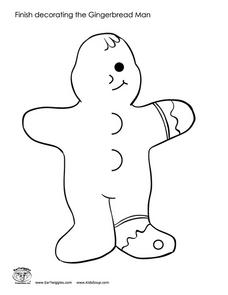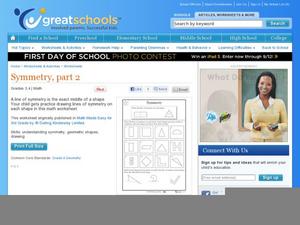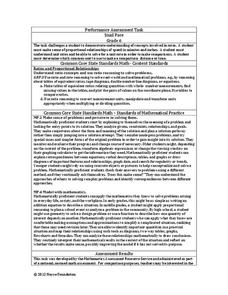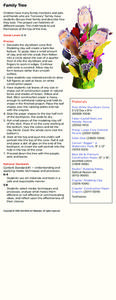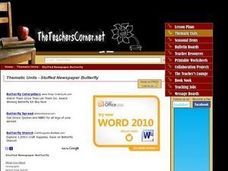ResourcesWeb & Docs
MediaVideo & Audio
CollectionsLessons & Topics
AI Teacher ToolsInstruction & Ideas
newFilter
37 results:
finishing the other half of a drawingClear All
Curated OER
Draw the Other Half
How can you make the two halves symetric? Scholars use the concept of symmetry to complete five images which are only half-drawn. The fun part about this exercise is that they aren't copying geometric shapes. There is a face, sun, kite,...
Curated OER
Face Study: Draw the Other Half
Build fine motor, spatial, and drawing skills by having the class complete the other half of a portrait. They choose an image of a face from a magazine, then attempt to draw the other half of the face as accurately as they can. Two book...
Curated OER
Symmetry
These symmetrical shapes are only half-completed, so scholars finish them by drawing the other side of the line of symmetry. Because your class won't recognize these abstract shapes, they will get authentic practice with this objective....
Curated OER
The Same
These monsters are only half-drawn! Challenge scholars to observe the line of symmetry and draw in the other half to reflect the first half. There are six simple monsters in all, and scholars can color them in once finished (encourage...
Curated OER
Symmetry (Bug)
Play around with symmetry with this worksheet! Learners examine an image of half of a bug drawn on grid paper and complete the drawing, making the image symmetrical. The bug contains curved lines as well as patterns to copy over to the...
DK Publishing
Spot the Doubles
Have fun with counting and ladybugs! Kindergartners count the number of spots on the first half of the bug's wings, then double the number to practice their addition skills. Have kids color the ladybugs when they're finished with the...
Curated OER
Finish Decorating the Gingerbread Man
For this preschool worksheet, students finish decorating a black line picture of a gingerbread man. They see one half of the gingerbread man on the right side and they draw in the other side.
Sargent Art
Protect Our Marine Life
Encourage water conservation and boost art skills with a hands-on activity that challenges young painters to create a scene highlighting marine life. Using oil pastels, scholars draw an underwater scene and write a tip for viewers to...
Curated OER
Symmetry Project
Learners explore the concept of symmetry by drawing an the other half of an object. They pick from a stack of magazine pictures and draw it on another piece of paper.
Busch Gardens
Create an Invertebrate
What better way for young biologists to learn about invertebrates than by creating their very own? Here, students are assigned a set of invertebrate characteristics and are asked to invent an imaginary ocean animal...
Curated OER
Symmetry, Part 2
How can you tell if shapes are symmetrical? Fourth graders study 12 shapes, and draw lines down the middle of shapes that have symmetry. Once they are finished, they complete shapes that are missing their symmetrical sides. Some shapes...
Desert Discovery
Saguaro Seasons
Elementary schoolers take a look at how the saguaro cactus adapts to the four seasons of the year. This amazing plant has distinct flowering and fruiting cycles within the summer season, and other cycles during the other seasons. Your...
Noyce Foundation
Snail Pace
Slow and steady wins the race? In the assessment task, scholars calculate the rates at which different snails travel in order to find the fastest snail. Hopefully, your class will move much more quickly in finishing the task!
Curated OER
Family Tree
A unique twist on a family tree project is a fun alternative to the traditional family tree drawing. This 3D family tree would make a great display for back to school night or open house. Presenting all the important people in their...
EngageNY
Construct a Square and a Nine-Point Circle
Anyone can draw a square, but can you CONSTRUCT a square? Here is a resource that challenges math scholars to create steps to finish their own construction. They test their ability to read and follow directions to complete a construction...
Curated OER
Accordion Fold Book
You can use these basic instructions to create a book using the accordion fold. This project can be used alongside nearly any other lesson. Have kids fold a book to create a science journal, chapter-by-chapter book summary, to house a...
Curated OER
MYSTERY PICTURES (Following Oral Directions)
Learners draw pictures while following simple instructions. They discuss the importance of following directions explicitly. They discuss the differences between each child's work. They follow a second set of directions.
Curated OER
Fact and Opinion Race
Third graders differentiate between fact and opinion. They determine if a statement is a fact or an opinion. Students race to be the first team to make it to the finish line while determining if statements are facts or opinions.
Curated OER
Making a Fantasy Line
Pupils distinguish events that occur in the fantasy and real world by drawing a fantasy line.
Curated OER
Create a Food Chain
Students explore the food chain and the ways that animals depend on each other and on plants for food. They create a paper chain with different colors relating to carnivores and herbivores. The chains are linked to the sun to create a...
Curated OER
Beginning of the Year Activity Using The Rainbow Fish
Students are read "The Rainbow Fish Big Book". They discuss how each one of them are unique in some way. They decorate their own fish to show their characteristics and shares it with the class so they are able to learn about each other.
Curated OER
The Rainbow Fish
Students are read the book "The Rainbow Fish" and summarize each page. They discuss actions they should be displaying to others. They critique the book and role-play being friends to end the activity.
Curated OER
Reacting to Literature
Students participate in two activities relating to a book that they have enjoyed and review using BooksLog. They break into groups with one group illustrating an action scene using Sketchy while the other uses PicoMap to create a web...
Curated OER
Stuffed Newspaper Butterfly
Students examine the parts of a butterfly. They use newspaper to build a replica of a butterfly. Students stuff the butterfly and paint it. They display the finished product.








